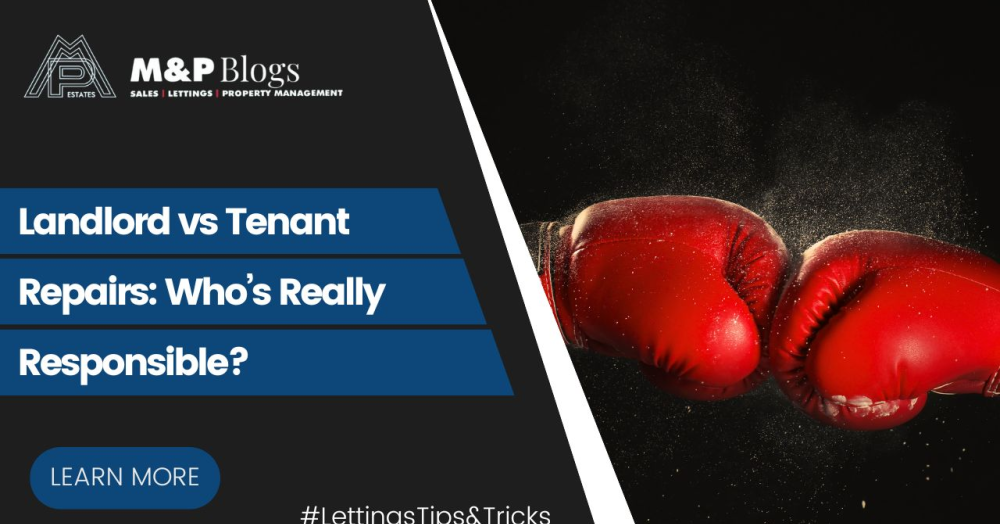Landlord or tenant—who’s responsible for repairs? From broken locks to faulty boilers, the law is clear: landlords must handle key maintenance while tenants take care of day-to-day upkeep. Knowing these responsibilities avoids disputes and keeps tenancies running smoothly.
Understanding the Legal Framework
Landlord repair obligations are not simply a matter of “best practice,” they are enshrined in law. The Landlord and Tenant Act 1985, Section 11 requires landlords to:
- Keep the structure and exterior of the property in repair (including walls, roof, foundations, drains, and external pipes).
- Maintain installations for the supply of water, gas, and electricity.
- Ensure heating and hot water systems are working properly.
- Keep sanitary fittings (toilets, baths, sinks) in good repair.
Meanwhile, the Homes (Fitness for Human Habitation) Act 2018 gives tenants the right to live in a property that is safe, healthy, and free from hazards such as damp, mould, and inadequate ventilation.
These legal duties cannot be contracted out of, even if a tenancy agreement attempts to place the responsibility on the tenant, it won’t override the law.
What Landlords Are Responsible For
In practice, landlords are responsible for:
- Locks, windows, and doors – If they break due to wear and tear or age.
- Heating systems and boilers – Including servicing and repairs.
- Electrical wiring – Ensuring installations remain safe.
- Plumbing and water systems – Pipes, drains, and water tanks.
- Structural repairs – Roofs, chimneys, walls, and foundations.
- Safety compliance – Gas safety checks, electrical checks, and smoke alarms.
If something essential breaks through no fault of the tenant, the landlord must act quickly to repair it.
What Tenants Are Responsible For
Tenants are expected to act in a “tenant-like manner.” While not strictly defined in law, case law suggests this includes:
- Keeping the property clean and tidy.
- Changing light bulbs and fuses.
- Preventing damage by ventilating rooms, using heating appropriately, and reporting issues promptly.
- Carrying out minor maintenance, such as tightening loose screws or unblocking a sink (if caused by them).
- Repairing or paying for damage caused by their negligence or misuse.
For example, if a lock breaks because the tenant forced the key or damaged it, they would be liable. If it breaks due to wear and tear, it falls on the landlord.
Grey Areas and Disputes
Disputes often arise around issues like damp or blocked drains. If the problem stems from the property’s structure or age, it is usually the landlord’s responsibility. If caused by the tenant’s actions, like failing to ventilate or flushing inappropriate items, it may be the tenant’s liability.
Good communication is key. Landlords should encourage tenants to report issues quickly and in writing, and tenants should not attempt major repairs themselves.
Why Compliance Matters
Ignoring repair obligations isn’t just a legal risk; it can damage relationships and reputations. Tenants who feel neglected are more likely to leave, leaving landlords with voids and additional costs. Worse, non-compliance can lead to enforcement action, rent repayment orders, or fines.
By staying proactive, carrying out regular inspections, scheduling maintenance, and working with a professional agent, landlords can protect their investment and maintain strong tenant relationships.
Final Thoughts
Landlords are responsible for the structure, safety, and essential services of their rental property, while tenants are responsible for everyday upkeep and damage they cause. Understanding this balance is crucial for compliance and for running a smooth, profitable tenancy.
At MP Estates, we help landlords stay on top of their responsibilities, ensuring properties remain compliant, tenants are happy, and investments are protected.
Are you a landlord unsure about your repair responsibilities?
Speak to M&P Estates today. We’ll guide you through your obligations, manage repairs efficiently, and give you peace of mind that your property is in safe hands.


